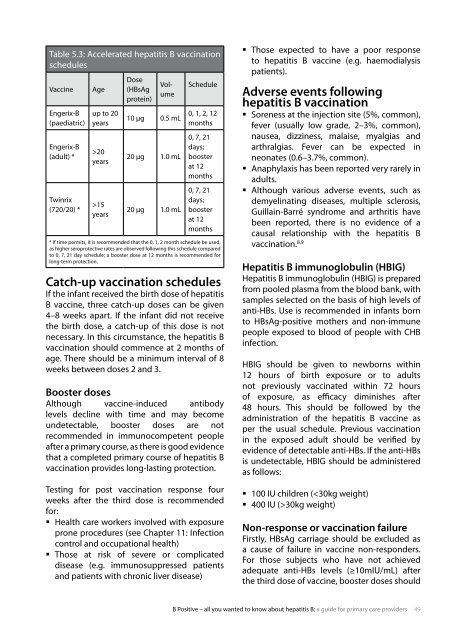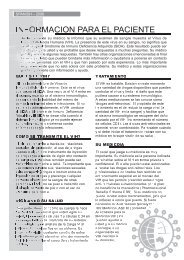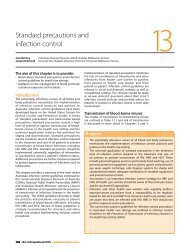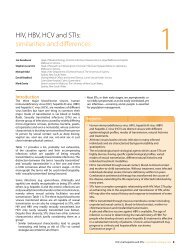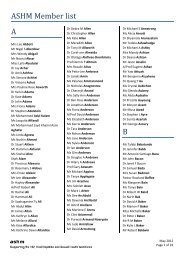B Positive – all you wanted to know about - ASHM
B Positive – all you wanted to know about - ASHM
B Positive – all you wanted to know about - ASHM
You also want an ePaper? Increase the reach of your titles
YUMPU automatically turns print PDFs into web optimized ePapers that Google loves.
table 5.3: accelerated hepatitis b vaccination<br />
schedules<br />
Vaccine age<br />
engerix-b<br />
(paediatric)<br />
engerix-b<br />
(adult) *<br />
twinrix<br />
(720/20) *<br />
up <strong>to</strong> 20<br />
years<br />
>20<br />
years<br />
>15<br />
years<br />
dose<br />
(Hbsag<br />
protein)<br />
Volume<br />
10 µg 0.5 mL<br />
20 µg 1.0 mL<br />
20 µg 1.0 mL<br />
schedule<br />
0, 1, 2, 12<br />
months<br />
0, 7, 21<br />
days;<br />
booster<br />
at 12<br />
months<br />
0, 7, 21<br />
days;<br />
booster<br />
at 12<br />
months<br />
* if time permits, it is recommended that the 0, 1, 2 month schedule be used,<br />
as higher seroprotective rates are observed following this schedule compared<br />
<strong>to</strong> 0, 7, 21 day schedule; a booster dose at 12 months is recommended for<br />
long-term protection.<br />
Catch-up vaccination schedules<br />
if the infant received the birth dose of hepatitis<br />
b vaccine, three catch-up doses can be given<br />
4<strong>–</strong>8 weeks apart. if the infant did not receive<br />
the birth dose, a catch-up of this dose is not<br />
necessary. in this circumstance, the hepatitis b<br />
vaccination should commence at 2 months of<br />
age. there should be a minimum interval of 8<br />
weeks between doses 2 and 3.<br />
Booster doses<br />
although vaccine-induced antibody<br />
levels decline with time and may become<br />
undetectable, booster doses are not<br />
recommended in immunocompetent people<br />
after a primary course, as there is good evidence<br />
that a completed primary course of hepatitis b<br />
vaccination provides long-lasting protection.<br />
testing for post vaccination response four<br />
weeks after the third dose is recommended<br />
for:<br />
� Health care workers involved with exposure<br />
prone procedures (see chapter 11: infection<br />
control and occupational health)<br />
� those at risk of severe or complicated<br />
disease (e.g. immunosuppressed patients<br />
and patients with chronic liver disease)<br />
� those expected <strong>to</strong> have a poor response<br />
<strong>to</strong> hepatitis b vaccine (e.g. haemodialysis<br />
patients).<br />
Adverse events following<br />
hepatitis B vaccination<br />
� soreness at the injection site (5%, common),<br />
fever (usu<strong>all</strong>y low grade, 2<strong>–</strong>3%, common),<br />
nausea, dizziness, malaise, myalgias and<br />
arthralgias. fever can be expected in<br />
neonates (0.6<strong>–</strong>3.7%, common).<br />
� anaphylaxis has been reported very rarely in<br />
adults.<br />
� although various adverse events, such as<br />
demyelinating diseases, multiple sclerosis,<br />
Guillain-barré syndrome and arthritis have<br />
been reported, there is no evidence of a<br />
causal relationship with the hepatitis b<br />
vaccination. 8,9<br />
Hepatitis B immunoglobulin (HBIG)<br />
Hepatitis b immunoglobulin (HbiG) is prepared<br />
from pooled plasma from the blood bank, with<br />
samples selected on the basis of high levels of<br />
anti-Hbs. use is recommended in infants born<br />
<strong>to</strong> Hbsag-positive mothers and non-immune<br />
people exposed <strong>to</strong> blood of people with cHb<br />
infection.<br />
HbiG should be given <strong>to</strong> newborns within<br />
12 hours of birth exposure or <strong>to</strong> adults<br />
not previously vaccinated within 72 hours<br />
of exposure, as efficacy diminishes after<br />
48 hours. this should be followed by the<br />
administration of the hepatitis b vaccine as<br />
per the usual schedule. Previous vaccination<br />
in the exposed adult should be verified by<br />
evidence of detectable anti-Hbs. if the anti-Hbs<br />
is undetectable, HbiG should be administered<br />
as follows:<br />
� 100 iu children (30kg weight)<br />
Non-response or vaccination failure<br />
firstly, Hbsag carriage should be excluded as<br />
a cause of failure in vaccine non-responders.<br />
for those subjects who have not achieved<br />
adequate anti-Hbs levels (≥10miu/mL) after<br />
the third dose of vaccine, booster doses should<br />
b <strong>Positive</strong> <strong>–</strong> <strong>all</strong> <strong>you</strong> <strong>wanted</strong> <strong>to</strong> <strong>know</strong> <strong>about</strong> hepatitis b: a guide for primary care providers 49


